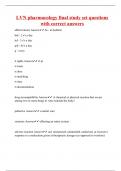LVN pharmacology final study set questions
with correct answers
abbreviations Answer ✔✔ hs - at bedtime
bid - 2 x's a day tid - 3 x's a day qid - 4x's a day
q - every
6 rights Answer✔✔ rt pt
rt route
rt dose
rt med/drug
rt time
rt documentation
drug incompatibility Answer ✔✔ A chemical or physical reaction that occurs among two or more drugs in vitro (outside the body)
palliative Answer ✔✔ comfort care
systemic Answer ✔✔ affecting an entire system
adverse reaction Answer ✔✔ any unexpected, unintended, undesired, or excessive response to a medication given at therapeutic dosages (as opposed to overdose) idiosyncratic reaction Answer ✔✔ unexpected effect produced in a particularly sensitive patient but not seen in most people
solubility of a drug Answer ✔✔ water soluble does not cross cell membrane
fat soluble will cross cell membrane and blood brain berrier
cumulative effect Answer ✔✔ Occurs when the body cannot metabolize one dose of a drug before another dose is administered
therapeutic range Answer ✔✔ Blood concentration of a drug that produces the desired effect without toxicity
additive effect Answer ✔✔ A drug interaction that occurs when two drugs with similar actions are taken, thus doubling the effect.
Parts of an order that a nurse would need to know before administering meds Answer✔✔ side effects
name of drug
Father of Medicine Answer ✔✔ Hippocrates
Mother of nursing Answer ✔✔ Florence Nightingale
nurses responsibility when giving medications Answer ✔✔ teach
know the therapeutic Antibiotics Answer ✔✔ a. Includes: penicillins, cephalosporins, tetracyclines, macrolides (erythromycins), sulfonamides (sulfa drugs), antiviral, antifungal, aminoglycides, fluoroquinolones, misc. chloromycetin, etc.
Anaphylactic shock Answer ✔✔ a severe and rapid and sometimes fatal hypersensitivity reaction to a substance (especially a vaccine or penicillin or shellfish or insect venom) to which the organism has become sensitized by previous exposure, sudden drop in blood pressure, difficulty breathing, unconsciousness, can be fatal
- 150 to 200 deaths a year
Superinfection Answer ✔✔ infection that occurs while you are being treated for another infection
New infection caused by a different organism from one that caused the initial infection; can occur from a harmful effect of an antibiotic, when there is an overgrowth of a resistant strain of bacteria, fungi, or yeast
How things are ordered: Answer ✔✔ q 4, q 6
Adverse reactions for the different groups of antibiotics Answer ✔✔ penicillin
Cephalosporins
Tetracyclines
macrolides
sulfonamides (sulfa drugs)
penicillin and adverse reactions Answer ✔✔ any of various antibiotics obtained from penicillium molds (or produced synthetically) and used in the treatment of various infections and diseases hypersensitivity: anaphylatic reactions, maculopapular rash, urticaria, etc. Interstitial nephritis (AIN), bone marrow toxicity, hepatitis, granulocytopenia
Cephalosporins Answer ✔✔ Class of antibiotics that have 10% cross sensitivity with penicillins
bactericidal
Indications- Pharyngitis, Tonsillitis, Otitis media, Upper and lower respiratory tract
infections, dermatological infections, gonorrhea, septicemia, meningitis, perioperative prophylaxis, UTI's
SE- Abdominal pain, nausea, vomiting, diarrhea, increased bleeding risk, hypoprothrombinemia, rash, superinfections, thrombophlebitic, abscess formation
Tetracyclines Answer ✔✔ Discolored teeth, - tetracycline - doxycycline - minocycline
USE: acne; drug of choice for Rickettsial disease, chlamydia, mycoplasma pneumoniae, yersinia pestis, borrelia
BACTERIOSTATIC
RESIST: decreased intracellular levels (by decreased influx or increased efflux); enzymatic inactivation of drug; expression of proteins that protect ribosomes from drug
KINETICS: PO abs decreased by di/trivalent cations (dairy, antacids, Fe suppl) and by hi pH (antacids); wide distribution; CROSSES CNS AND PLACENTA; accumulation in liver, marrow, bone, dentine and enamel of unerupted teeth (inactive form accumulates in teeth); excretion is mostly thru kidneys
EXCEPTIONS: doxycline is NOT eliminated via kidneys (eliminated as an inactive chelate or conjugate in feces), and minocycline is metabolized in the liver, passed in feces




